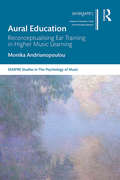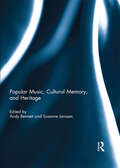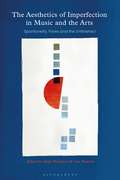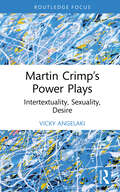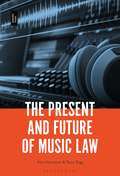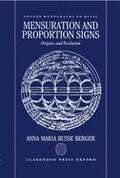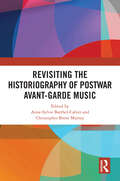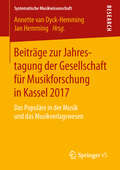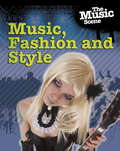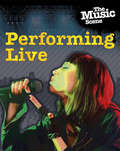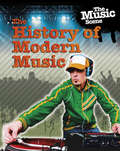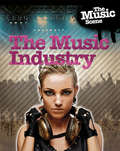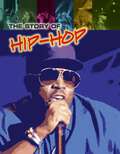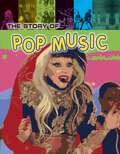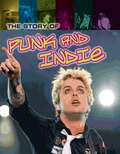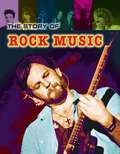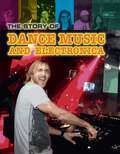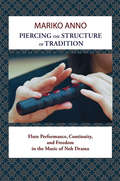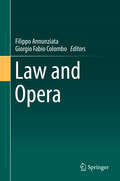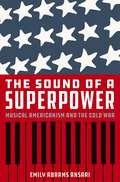- Table View
- List View
Aural Education: Reconceptualising Ear Training in Higher Music Learning (SEMPRE Studies in The Psychology of Music)
by Monika AndrianopoulouAural Education: Reconceptualising Ear Training in Higher Music Learning explores the practice of musical ‘aural training’ from historical, pedagogical, psychological, musicological, and cultural perspectives, and uses these to draw implications for its pedagogy, particularly within the context of higher music education. The multi-perspective approach adopted by the author affords a broader and deeper understanding of this branch of music education, and of how humans relate to music more generally. The book extracts and examines one by one different parameters that appear central to ‘aural training’, proceeding in a gradual and well-organised way, while at the same time constantly highlighting the multiple interconnections and organic unity of the many different operations that take place when we interact with music through any music-related activity. The resulting complex profile of the nature of our relationship with music, combined with an exploration of non-Western cultural perspectives, offer fresh insights on issues relating to musical ‘aural training’. Emerging implications are proposed in the form of broad pedagogical principles, applicable in a variety of different music educational settings. Andrianopoulou propounds a holistic alternative to ‘aural training’, which acknowledges the richness of our relationship to music and is rooted in absorbed aural experience. The book is a key contribution to the existing literature on aural education, designed with researchers and educators in mind.
Aural Education: Reconceptualising Ear Training in Higher Music Learning (SEMPRE Studies in The Psychology of Music)
by Monika AndrianopoulouAural Education: Reconceptualising Ear Training in Higher Music Learning explores the practice of musical ‘aural training’ from historical, pedagogical, psychological, musicological, and cultural perspectives, and uses these to draw implications for its pedagogy, particularly within the context of higher music education. The multi-perspective approach adopted by the author affords a broader and deeper understanding of this branch of music education, and of how humans relate to music more generally. The book extracts and examines one by one different parameters that appear central to ‘aural training’, proceeding in a gradual and well-organised way, while at the same time constantly highlighting the multiple interconnections and organic unity of the many different operations that take place when we interact with music through any music-related activity. The resulting complex profile of the nature of our relationship with music, combined with an exploration of non-Western cultural perspectives, offer fresh insights on issues relating to musical ‘aural training’. Emerging implications are proposed in the form of broad pedagogical principles, applicable in a variety of different music educational settings. Andrianopoulou propounds a holistic alternative to ‘aural training’, which acknowledges the richness of our relationship to music and is rooted in absorbed aural experience. The book is a key contribution to the existing literature on aural education, designed with researchers and educators in mind.
Popular Music, Cultural Memory, and Heritage
by Andy Bennett and Susanne JanssenPopular music is increasingly being represented and celebrated as an aspect of contemporary cultural history and heritage. In many places across the world, popular music heritage sites – including museums, archives, commemorative plaques adorning buildings, and what could be referred to as DIY music heritage initiatives – constitute some of the key ways in which popular music artists, scenes and events are being remembered. Bringing together a selection of wide-ranging contributions, the purpose of this book is to present a number of case studies from Europe and Australia that demonstrate the variety of ways in which popular music is being cast as cultural heritage and as a medium that invokes the collective memory of successive generations whose identity and sense of cultural belonging have often been indelibly inscribed by the musical soundscapes of their teen and early adult years. This book was originally published as a special issue of Popular Music and Society.
The Aesthetics of Imperfection in Music and the Arts: Spontaneity, Flaws and the Unfinished
by Andy Hamilton and Lara PearsonThe aesthetics of imperfection emphasises spontaneity, disruption, process and energy over formal perfection and is often ignored by many commentators or seen only in improvisation. This comprehensive collection is the first time imperfection has been explored across all kinds of musical performance, whether improvisation or interpretation of compositions. Covering music, visual art, dance, comedy, architecture and design, it addresses the meaning, experience, and value of improvisation and spontaneous creation across different artistic media. A distinctive feature of the volume is that it brings together contributions from theoreticians and practitioners, presenting a wider range of perspectives on the issues involved. Contributors look at performance and practice across Western and non-Western musical, artistic and craft forms. Composers and non-performing artists offer a perspective on what is 'imperfect' or improvisatory within their work, contributing further dimensions to the discourse. The Aesthetics of Imperfection in Music and the Arts features 39 chapters organised into eight sections and written by a diverse group of scholars and performers. They consider divergent definitions of aesthetics, employing both 18th-century philosophy and more recent socially and historically situated conceptions making this an essential, up-to-date resource for anyone working on either side of the perfection-imperfection debate.
Martin Crimp’s Power Plays: Intertextuality, Sexuality, Desire (Routledge Advances in Theatre & Performance Studies)
by Vicky AngelakiThis book covers playwright Martin Crimp’s recent work showing how it captures the nuances in our interpersonal contemporary experience. Examining the bold and exciting body of writing by Crimp, the book delves into his depiction of intersections between narratives, as well as between private and public, through an honest look at power structures and shifts, marriages and relationships, sexuality, and desire. This book will be of great interest to students and scholars in Drama, Theatre and Performance, English Literature, and Opera Studies.
Martin Crimp’s Power Plays: Intertextuality, Sexuality, Desire (Routledge Advances in Theatre & Performance Studies)
by Vicky AngelakiThis book covers playwright Martin Crimp’s recent work showing how it captures the nuances in our interpersonal contemporary experience. Examining the bold and exciting body of writing by Crimp, the book delves into his depiction of intersections between narratives, as well as between private and public, through an honest look at power structures and shifts, marriages and relationships, sexuality, and desire. This book will be of great interest to students and scholars in Drama, Theatre and Performance, English Literature, and Opera Studies.
The Present and Future of Music Law
by Ann Harrison and Tony RiggThe music business is a multifaceted, transnational industry that operates within complex and rapidly changing political, economic, cultural and technological contexts. The mode and manner of how music is created, obtained, consumed and exploited is evolving rapidly. It is based on relationships that can be both complimentary and at times confrontational, and around roles that interact, overlap and sometimes merge, reflecting the competing and coinciding interests of creative artists and music industry professionals. It falls to music law and legal practice to provide the underpinning framework to enable these complex relationships to flourish, to provide a means to resolve disputes, and to facilitate commerce in a challenging and dynamic business environment. The Present and Future of Music Law presents thirteen case studies written by experts in their fields, examining a range of key topics at the points where music law and the post-digital music industry intersect, offering a timely exploration of the current landscape and insights into the future shape of the interface between music business and music law.
Mensuration And Proportion Signs: Origins And Evolution (Oxford Monographs On Music)
by Anna Maria Busse BergerCounter In the fourteenth century composers and theorists invented mensuration and proportion signs that allowed them increased flexibility and precision in notating a wide range of rhythmic and metric relationships. The origin and interpretation of these signs is one of the least understood and most complex issues in music history. This study represents the first attempt to see the origin of musical mensuration and proportion signs in the context of other measuring systems of the fourteenth century. Berger analyzes the exact meaning of every mensuration and proportion sign in music and theory from the fourteenth to the sixteenth century, and offers revisions of many currently-held views concerning the significance and development of early time signatures.
Revisiting the Historiography of Postwar Avant-Garde Music
by Anne-Sylvie Barthel-Calvet and Christopher Brent MurrayThis collection of essays delves into the historiographical traditions that have dominated how the stories of European postwar avant-garde music are told, seeking to approach commonplaces of that history writing from new perspectives. The contributors revisit subjects as varied as the impact of long-playing records on the emergence of open works, Messiaen’s interest in non-European musical traditions, Xenakis’s turn to information theory, Kagel’s strategic invention of a new genre, Berio’s dependence on funding from American foundations, and the ways in which figures like Boulez, Stockhausen, Pousseur, and Nono constructed their musical ancestries. Leading experts in their respective fields, the volume’s authors have sought to rethink the historiography of European experimental music of the 1950s, 1960s, and 1970s in ways that resituate that small but influential milieu in broader historical and cultural contexts. In doing so, they suggest new directions and insights for students and specialists of twentieth-century music and music historiography.
Beiträge zur Jahrestagung der Gesellschaft für Musikforschung in Kassel 2017: Das Populäre in der Musik und das Musikverlagswesen (Systematische Musikwissenschaft)
by Annette van Dyck-Hemming Jan HemmingDieses Buch versammelt Ansätze der Musikwissenschaft, die auf der Tagung der Gesellschaft für Musikforschung in Kassel 2017 diskutiert wurden. Studien zu Gitarrenriffs im Heavy Metal, Vokalmusik der Renaissance oder Techno stehen dabei neben Untersuchungen zum Einfluss Th. W. Adornos auf die Forschung und Forderungen, populäre Musik ernst zu nehmen. Zweiter Themenschwerpunkt sind Verlage, ihre Netzwerke und ihr Verhältnis u. a. zu Beethoven sowie Fragen zu Urheberrecht und digitaler Publikation. Der Band dokumentiert die Vielfalt musikologischer Forschung, die sich mit Musikwirtschaft und -software, Aufnahmetechnik, aber auch Instrumentenbau, Klaviersonaten und der Freundschaft zwischen Luciano Berio und Umberto Eco beschäftigt, und gibt so Antworten auf aktuelle und historische musikalische Fragen.
The Music Scene: Music, Fashion and Style (The\music Scene Ser.)
by Matt AnnissThe Music Scene offers a detailed yet readable look at the world of contemporary music for young people. Full of practical, how-to advice and fascinating case studies on many of the world's favourite bands and artists, The Music Scene examines live gigs, recording and contracts, publicity, merchandising and changing fashions in contemporary music. Written by a music journalist, The Music Scene is certain to strike a chord with any aspiring young pop musician.
The Music Scene: Performing Live (The\music Scene Ser.)
by Matt AnnissThe Music Scene offers a detailed yet readable look at the world of contemporary music for young people. Full of practical, how-to advice and fascinating case studies on many of the world's favourite bands and artists, The Music Scene examines live gigs, recording and contracts, publicity, merchandising and changing fashions in contemporary music. Written by a music journalist, The Music Scene is certain to strike a chord with any aspiring young pop musician.
The Music Scene: The History of Modern Music (The\music Scene Ser.)
by Matt AnnissThe Music Scene offers a detailed yet readable look at the world of contemporary music for young people. Full of practical, how-to advice and fascinating case studies on many of the world's favourite bands and artists, The Music Scene examines live gigs, recording and contracts, publicity, merchandising and changing fashions in contemporary music. Written by a music journalist, The Music Scene is certain to strike a chord with any aspiring young pop musician.
The Music Scene: The Music Industry (The\music Scene Ser.)
by Matt AnnissThe Music Scene offers a detailed yet readable look at the world of contemporary music for young people. Full of practical, how-to advice and fascinating case studies on many of the world's favourite bands and artists, The Music Scene examines live gigs, recording and contracts, publicity, merchandising and changing fashions in contemporary music. Written by a music journalist, The Music Scene is certain to strike a chord with any aspiring young pop musician.
The Story of Hip Hop (Pop Histories)
by Matt AnnissTake a journey through the hard-hitting history of hip-hop music. Witness DJ Kool Herc's first block parties and the origins of hip-house and scratching. See how cheap drum machines and talented turntablists changed music forever and meet some of the hip-hop scene's greatest stars. ABOUT THE SERIES: This heavily illustrated, magazine-style series tells the story of music from the 50s to the present day, featuring quotes from contemporary artists about their influences and inspirations.
The Story of Pop Music (Pop Histories)
by Matt AnnissTake a journey through the sensational history of pop music. Witness the early days of pop, and get the inside track on how managers created groups and shaped their world famous sounds. See how music television transformed the industry and meet pop's greatest stars.
The Story of Punk and Indie (Pop Histories)
by Matt AnnissTake a journey through the riotous history of punk and indie music. Experience the origins of post-punk, Britpop, indie-pop and alternative rock music. See how dance and grunge music made an impact and meet some of punk and indie's greatest stars. ABOUT THE SERIES: This heavily illustrated, magazine-style series tells the story of music from the 50s to the present day, featuring quotes from contemporary artists about their influences and inspirations.
The Story of Rock (Pop Histories)
by Matt AnnissTake a journey through the rip-roaring history of rock music. Find out about the origins of rock and roll, progressive, and heavy metal. See how indie and grunge music made an impact and meet some of rock's greatest stars. ABOUT THE SERIES: This heavily illustrated, magazine-style series tells the story of music from the 50s to the present day, featuring quotes from contemporary artists about their influences and inspirations.
The Story of Techno and Dance Music (Pop Histories)
by Matt AnnissTake a journey through the radical history of techno and dance music. Find out about the origins of house, techno, hardcore, and chill out music. Witness how the synthesizer changed the dance music world forever and meet the world's biggest superstar DJs. ABOUT THE SERIES: This heavily illustrated, magazine-style series tells the story of music from the 50s to the present day, featuring quotes from contemporary artists about their influences and inspirations.
Piercing the Structure of Tradition: Flute Performance, Continuity, and Freedom in the Music of Noh Drama
by Mariko AnnoWhat does freedom sound like in the context of traditional Japanese theater? Where is the space for innovation, and where can this kind of innovation be located in the rigid instrumentation of the Noh drama? In Piercing the Structure of Tradition, Mariko Anno investigates flute performance as a space to explore the relationship between tradition and innovation. This first English-language monograph traces the characteristics of the Noh flute (nohkan), its music, and transmission methods and considers the instrument's potential for development in the modern world. Anno examines the musical structure and nohkan melodic patterns of five traditional Noh plays and assesses the degree to which Issō School nohkan players maintain to this day the continuity of their musical traditions in three contemporary Noh plays influenced by Yeats. Her ethnographic approach draws on interviews with performers and case studies, as well as her personal reflection as a nohkan performer and disciple under the tutelage of Noh masters. She argues that traditions of musical style and usage remain influential in shaping contemporary Noh composition and performance practice, and the existing freedom within fixed patterns can be understood through a firm foundation in Noh tradition.
Law and Opera
by Filippo Annunziata Giorgio Fabio ColomboThis book explores the various connections between Law and Opera, providing a comprehensive, multinational, and multidisciplinary (with approaches from jurists, philosophers, musicologist, historians) resource on the subject. Further, it makes a valuable contribution to studies on law and the humanities. While, for example, the relationship between law and literature has been extensively researched, the relationship between Law and Opera remains largely overlooked. The book approaches the topic from three perspectives in three main sections: Law in Opera, Law on Opera, and Law around Opera.
The Sound of a Superpower: Musical Americanism and the Cold War
by Emily Abrams AnsariClassical composers seeking to create an American sound enjoyed unprecedented success during the 1930s and 1940s. Aaron Copland, Roy Harris, Howard Hanson and others brought national and international attention to American composers for the first time in history. In the years after World War II, however, something changed. The prestige of musical Americanism waned rapidly as anti-Communists made accusations against leading Americanist composers. Meanwhile a method of harmonic organization that some considered more Cold War-appropriate--serialism--began to rise in status. For many composers and historians, the Cold War had effectively "killed off" musical Americanism. In The Sound of a Superpower: Musical Americanism and the Cold War, Emily Abrams Ansari offers a fuller, more nuanced picture of the effect of the Cold War on Americanist composers. The ideological conflict brought both challenges and opportunities. Some Americanist composers struggled greatly in this new artistic and political environment. Those with leftist politics sensed a growing gap between the United States that their music imagined and the aggressive global superpower that their nation seemed to be becoming. But these same composers would find unique opportunities to ensure the survival of musical Americanism thanks to the federal government, which wanted to use American music as a Cold War propaganda tool. By serving as advisors to cultural diplomacy programs and touring as artistic ambassadors, the Americanists could bring their now government-backed music to new global audiences. Some with more right-wing politics, meanwhile, would actually flourish in the new ideological environment, by aligning their music with Cold War conceptions of American identity. The Americanists' efforts to safeguard the reputation of their style would have significant consequences. Ultimately, Ansari shows, they effected a rebranding of musical Americanism, with consequences that remain with us today.
The Sound of a Superpower: Musical Americanism and the Cold War
by Emily Abrams AnsariClassical composers seeking to create an American sound enjoyed unprecedented success during the 1930s and 1940s. Aaron Copland, Roy Harris, Howard Hanson and others brought national and international attention to American composers for the first time in history. In the years after World War II, however, something changed. The prestige of musical Americanism waned rapidly as anti-Communists made accusations against leading Americanist composers. Meanwhile a method of harmonic organization that some considered more Cold War-appropriate--serialism--began to rise in status. For many composers and historians, the Cold War had effectively "killed off" musical Americanism. In The Sound of a Superpower: Musical Americanism and the Cold War, Emily Abrams Ansari offers a fuller, more nuanced picture of the effect of the Cold War on Americanist composers. The ideological conflict brought both challenges and opportunities. Some Americanist composers struggled greatly in this new artistic and political environment. Those with leftist politics sensed a growing gap between the United States that their music imagined and the aggressive global superpower that their nation seemed to be becoming. But these same composers would find unique opportunities to ensure the survival of musical Americanism thanks to the federal government, which wanted to use American music as a Cold War propaganda tool. By serving as advisors to cultural diplomacy programs and touring as artistic ambassadors, the Americanists could bring their now government-backed music to new global audiences. Some with more right-wing politics, meanwhile, would actually flourish in the new ideological environment, by aligning their music with Cold War conceptions of American identity. The Americanists' efforts to safeguard the reputation of their style would have significant consequences. Ultimately, Ansari shows, they effected a rebranding of musical Americanism, with consequences that remain with us today.
How Music Helps in Music Therapy and Everyday Life (Music and Change: Ecological Perspectives)
by Gary AnsdellWhy is music so important to most of us? How does music help us both in our everyday lives, and in the more specialist context of music therapy? This book suggests a new way of approaching these topical questions, drawing from Ansdell's long experience as a music therapist, and from the latest thinking on music in everyday life. Vibrant and moving examples from music therapy situations are twinned with the stories of 'ordinary' people who describe how music helps them within their everyday lives. Together this complementary material leads Ansdell to present a new interdisciplinary framework showing how musical experiences can help all of us build and negotiate identities, make intimate non-verbal relationships, belong together in community, and find moments of transcendence and meaning. How Music Helps is not just a book about music therapy. It has the more ambitious aim to promote (from a music therapist's perspective) a better understanding of 'music and change' in our personal and social life. Ansdell's theoretical synthesis links the tradition of Nordoff-Robbins music therapy and its recent developments in Community Music Therapy to contemporary music sociology and music studies. This book will be relevant to practitioners, academics, and researchers looking for a broad-based theoretical perspective to guide further study and policy in music, well-being, and health.
How Music Helps in Music Therapy and Everyday Life (Music and Change: Ecological Perspectives)
by Gary AnsdellWhy is music so important to most of us? How does music help us both in our everyday lives, and in the more specialist context of music therapy? This book suggests a new way of approaching these topical questions, drawing from Ansdell's long experience as a music therapist, and from the latest thinking on music in everyday life. Vibrant and moving examples from music therapy situations are twinned with the stories of 'ordinary' people who describe how music helps them within their everyday lives. Together this complementary material leads Ansdell to present a new interdisciplinary framework showing how musical experiences can help all of us build and negotiate identities, make intimate non-verbal relationships, belong together in community, and find moments of transcendence and meaning. How Music Helps is not just a book about music therapy. It has the more ambitious aim to promote (from a music therapist's perspective) a better understanding of 'music and change' in our personal and social life. Ansdell's theoretical synthesis links the tradition of Nordoff-Robbins music therapy and its recent developments in Community Music Therapy to contemporary music sociology and music studies. This book will be relevant to practitioners, academics, and researchers looking for a broad-based theoretical perspective to guide further study and policy in music, well-being, and health.
